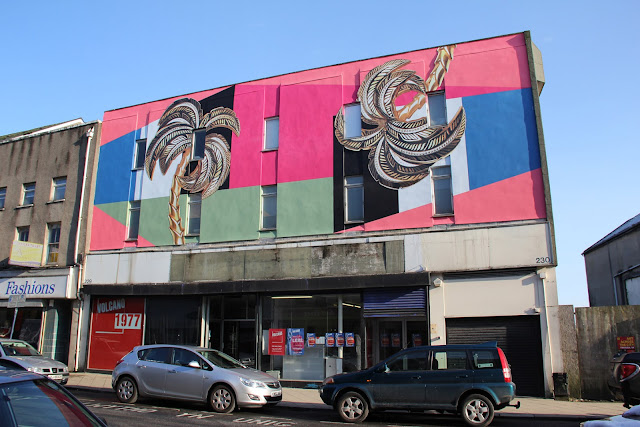
Sinta Tantra created one of my favourite installations at last year's Biennial, which is still in place, the facade at the Open Eye Gallery.
How did you become an artist?
I don't think I was particularly interested in art when I was younger; I was much more of a musical kid. At school I played the piano, trumpet and sang. It was only until my late teens that my attitudes towards art developed. I preferred the more contemplative side of art making; the creative process seemed more private and I took refuge in the fact that you didn't necessarily need to 'perform' in front of an audience. Fast forward another 15 years and ironically, what we see now is a practice all about engaging with audiences and people - from the passerby who encounters the work on street level, to those I work closely with on production and pre production. There's a strong visual formalism too which is rooted in my learning about musical composition and four part harmony.
What was your inspiration for newest commission?
I am inspired by stories and the framework of narrative. Narrative (meta or grand) acts as a cultural wormhole that enables one to be completely submerged in another space or being. The title of my latest public art commission in Swansea is called, 'A Greater Reality of Elsewhere'. It is a quote taken from a Truman Capote travel sketch essay of New York City. I enjoy Capote’s sharp style of writing which lies somewhere in-between story telling and journalistic reportage. As an artist I am intrigued by the ‘fantasy / fiction’ duality - especially in the context of pop culture and the world of art. ‘Romantic truth’, as seen in the drip paintings of Pollock, has been replaced by the 'genuine fake' of Warhol – and it is this sense of hyperreality that I wanted to bring into my work in Swansea.

What was the trickiest element to achieve?
For me the trickiest part of any commission is engaging with the local context and site - creating a work which is both intriguing and challenging. Previously, the only facts I knew about Swansea were Dylan Thomas and beaches. When visiting Swansea I was struck by the cultural diversity as seen on St. Helen’s Road. Walking past you’ll see Welsh next to Ethiopian, next to Chinese, next to an Indian, next to Italian – and coming from Bali, I was particularly drawn to the unexpected presence of an little Indonesian restaurant called 'Garuda'. Although I am very used to towns and cities dividing themselves into cultural neighbourhoods such as ‘China Town’ or ‘Little India’, I have never seen such a crazy cultural mish-mash on such a small stretch of road. I wanted to create a piece of work that reflected this experience and challenged the stereotypes of Swansea – injecting a sense of exotica and tropical deco into the fabric of the town itself.
Of everything you've done what have you been most pleased with?
Most artists are very critical of everything they do. Its a game of highs and lows - figuring out what you want to say, how you are going to say it and whether what you have to say has any real significance to anyone, anywhere. To answer to your question, for me there is not one particular piece that highlights my career, rather its about developing a practice that's in it for the long haul. What I am most pleased about though, is the fact that I have somehow figured out a way of working which enables me to visit extraordinary places and meet the most interesting people.
I really love your Open Eye Gallery installation. How do you go about designing a composition when it's the facade of a building like that?
As you know, Open Eye Gallery sits within a new development on Liverpool's waterfront, Mann Island. One of my first tasks was to talk to the two architects involved with the development: Matt Brooks from Broadway Malyan (who designed Mann Island) and Tim Riley from RCKA (who designed Open Eye Gallery). I was intrigued to find out what types of buildings they wanted to create, the type of social and historical dialogues they wanted to engage in, their thoughts on art, architecture, community. On a very practical level though, I would say that I work very much like a designer but not like a designer. I draw on the computer, make models, animations, write e mails - but rather than pursuing a total concept from start to finish, I give myself much more of a licence to change direction whenever it feels necessary, exploring new tangents and avenues to the slight worry of my commissioners.
Who’s your favourite artist?
Can I cheat and mention a few? In my staple diet I have: Matisse, Sol le Witt, Paolozzi, anyone and everyone from the Bauhaus - a wonderful Balinese artist called Nyoman Lempad who made the most exquisite drawings - Duchamp, Beuys, Jorge Pardo, Polly Applebaum.
What stops you from feeling listless?
Radio 4's Desert Island Discs, Dim Sum in China town, cocktails and conversations, Farrow and Ball paints, vintage hats, black and white films, swimming and sunbathing either by the beach or by the pool but with a pair of Italian sunglasses.
Sinta's new work, A Greater Reality of Elsewhere is part of Swansea's Art Across The City festival which runs at locations across Swansea from 28 March – 12 May 2013.

No comments:
Post a Comment